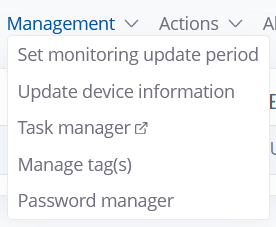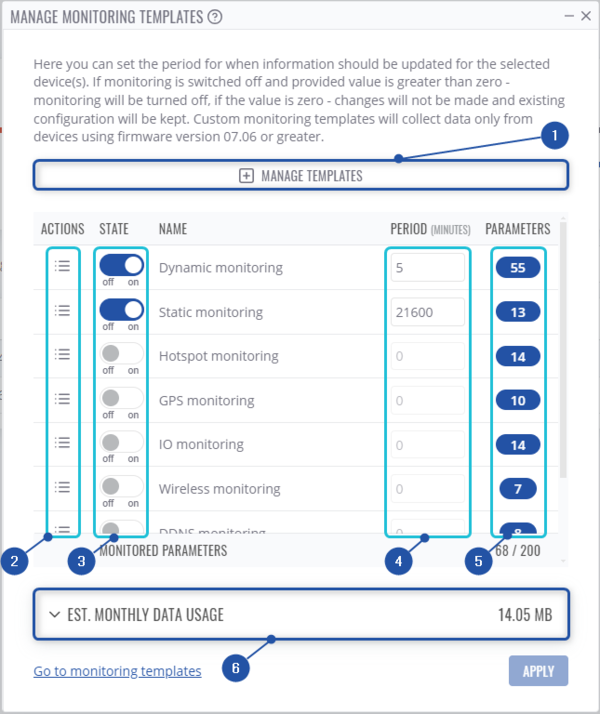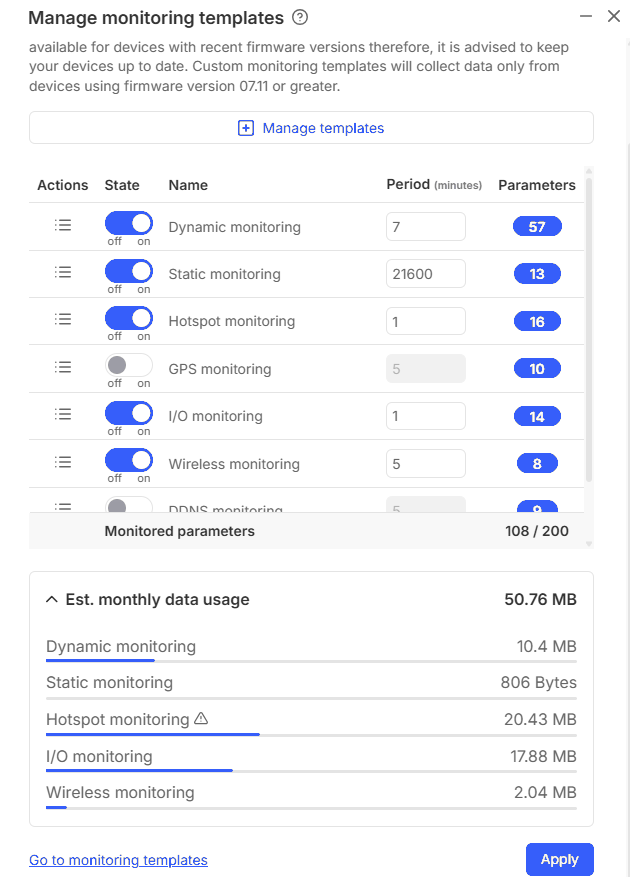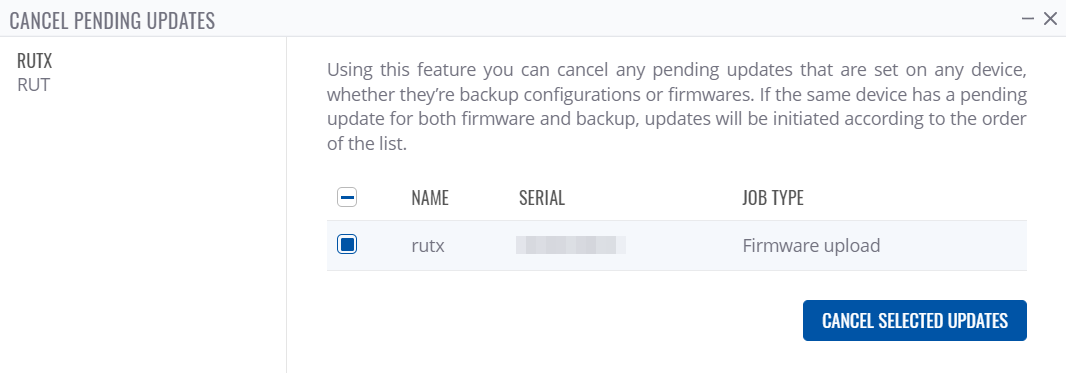RMS Management menu
Summary
The Management menu is located on the Devices section allows to set up parameter update intervals for the registered devices. It can optimize the monitoring process and reduce monthly data usages for devices registered on your RMS profile. This section of the RMS user manual provides an overview of the Monitoring top control menu.
Manage monitoring templates
The Manage monitoring templates provides the possibility to select custom monitoring templates, enable/disable them and configure custom time intervals at which router parameter values are updated in the RMS.
To change monitoring options for your device, go to the RMS web page, Left sidebar panel (Management → Devices), and click on the Devices.
Move your mouse pointer to the top control Management menu and select Manage monitoring templates (Management → Manage monitoring templates).
- Manage templates opens up a submenu, where you can add your custom monitoring templates that you've created.
- From this submenu, you can assign custom templates to your device.
- Note: assigned templates need to be enabled in order to monitored the configured paramaters as the template by default is added in disabled state.
- View parameters history, will redirect you to Monitoring History tab in Device's details page. Note: this option will not be displayed if you select multiple devices, you must select each device separataly.
- Enable/disable monitoring template.
- Set monitoring update period.
- View paramaters that are being monitored on the template.
Step by step instructions
- First, choose a device(s) for which the configuration will apply. If you select multiple devices, it will not display current parameters.
- Move your mouse pointer to the top control menu and in Management menu click "Manage monitoring templates".
- Then, a new pop-up window should appear. Place checkmarks next to relevant parameters to set up custom monitoring intervals. You can set up the monitoring update frequency (in minutes).
- As you change these settings, the system will calculate an estimated monthly data usage value below in real-time.
At the top of your screen, you will get a notification in green text: Device updated.
- Dynamic monitoring - updates these parameters: SIM State, PIN State, NET State, Signal, Operator, Operator Number, Connection State, Connection Type, RX Count(T/Y), TX Count(Y/Y), Firmware Version, SIM Slot, Router Uptime, Connection Uptime, Mobile IP, Cell ID, MCC, MNC, LAC, RX Day, RX Week ,RX Month, TX Day, TX Week, TX Month, ICCID, WAN State, WAN IP, Temperature.
- Static monitoring - updates these parameters: IMEI, Model, Manufacturer, Revision, IMSI, Product Code, Batch Number, Hardware Revision.
- Hotspot monitoring - updates these parameters: Hotspot ID, Hotspot SSID, Hotspot Enabled, IP, Download, Upload, Download Limit, Upload Limit, Hotspot Users, Hotspot Users Pass, Hotspot User Active, Hotspot User Macs, Hotspot User Ips, Hotspot User Start Times, Hotspot User Use Times, Hotspot User Downloads, Hotspot User Uploads.
- I/O monitoring - updates these parameters: Digital Input, Digital Isolated Input, Analog Input, Digital OC Output, Digital Relay Output, Relay CFG, Output CFG.
- GPS monitoring - GPS monitoring updates these parameters: Latitude, Longitude, FIX, Altitude, Speed, Satellites, Course, Status, Enabled, Accuracy.
- Wireless monitoring - updates these parameters: Access point status, SSID, sent/received bytes per session, client count, connected device name, connected device MAC address, connected device IP address.
Estimated monthly data usage
Estimated data usage calculates an estimate of monthly data usage based on the update period values specified above.
Monitoring History
Here, you'll be able to view the data collected by your enabled monitoring templates over a chosen time period.
To view a desired monitoring template's data:
- Select a date range.
- Select a template to get a list of monitored parameters.
Once the template is selected, you can then choose to view By template or By parameter. In By template view, you will see all parameter section's values at the selected timestamp. While in By parameter view, you will see a specific parameter's values over a selected date range
View by template
Instructions
- Select By template.
- Select the timestamp to view monitored parameter values at that time.
- Select a monitored parameter section/group.
- On the right side you will see parameter values at the selected time.
View by parameter
Instructions
- Select By parameter.
- Select a monitored parameter section/group.
- Select specific parameter.
- On the right side you will see selected parameter's values during the selected date range.
View pending task
The View pending task allows you to view and cancel any pending tasks. Cancel updates provides an option to manage all the pending jobs. To access it go to the RMS web page, Left sidebar panel, (Management → Devices), then click on Actions button and expand Management submenu.
Step by step instructions
Read step by step instructions to learn how to view and cancel pending tasks.
- Move your mouse pointer to the Actions menu, expand Management submenu and click "View pending tasks".
- After a pop-up window will appear. Select the the actions you want to cancel.
- Click the Cancel selected button.
- You can safely close the pop-up window.
At the top of your screen, you will get a notification:
Manage tag(s)
In this window you'll be able to:
- Assign selected tags on selected devices.
- Overwrite selected tags on selected devices.
- Remove selected tags from selected devices.
- Clear all tags from selected devices.
To create or remove tags, navigate to RMS Tags.
Actions from file
The CSV file should contain a serial number / MAC address (both Serial number and MAC address can be used interchangeably but not simultaneously), and a parameter you're configuring. Everything should be separated by commas (,) and each device should be in a separate line.
Set location from file
Here, you can set devices location from a file. In each row, you will need to provide the device's serial number / MAC address and location coordinates.
![]()
Change name from file
Here, you can change devices' name from a file. In each row, you will need to provide the device's serial number / MAC address, name, and description.

Assign device's tags from file
Here, you can assign a tag to devices from a file. In each row, you will need to provide the device's serial number / MAC address and choose tags to assign in the pop-up window.

Verify devices from file
Here, you can verify device's password from a file. In each row, you will need to provide the device's serial number / MAC address and password.











